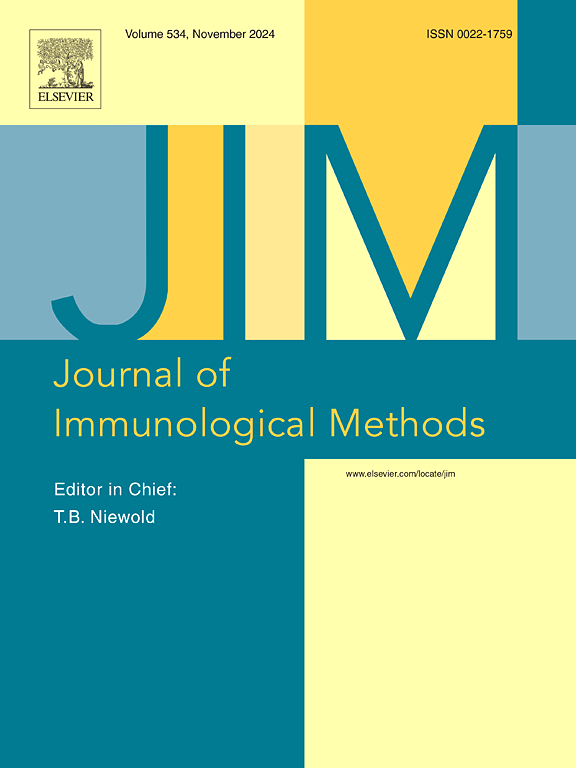Development of an ELISA strategy for the serological diagnosis of farmer's lung disease
IF 1.6
4区 医学
Q4 BIOCHEMICAL RESEARCH METHODS
引用次数: 0
Abstract
Context
Farmer's lung disease (FLD) is a form of hypersensitivity pneumonitis due to regular exposure to microbial antigens present in moldy hay. Serological diagnosis is usually based on immunoprecipitation techniques using 1 to 12 in-house antigens. To improve standardization, recombinant antigens (r-Ags) have been produced from three etiological agents involved in FLD.
Aim
The aim of this study was to develop a strategy using an ELISA test for the serological diagnosis of FLD.
Methods
The ELISA strategy was developed on an initial group of patients and then validated using sera from 29 patients with FLD and 54 exposed but non-FLD patients. Using sera from the second group of patients, the ELISA was simplified by using purified antigens from Saccharopolyspora rectivirgula, Lichtheimia corymbifera, and Eurotium amstelodami, each mixed with a corresponding r-Ag. The performance of the ELISA was evaluated according to the antigens used and also associated with an immunoprecipitation technique.
Results
The ELISA test using three purified antigens (PAgs) mixed with 3 r-Ags showed a sensitivity of 97 % and a specificity of 83 % (AUC: 0.84). The use of ELISA as a screening technique and double diffusion (using 6 somatic antigens) as a confirmatory technique in cases of moderate or positive ELISAs showed a sensitivity of 93 % and a specificity of 84 % (AUC: 0.86).
Conclusion
The use of a mixture of purified protein antigens and highly standardized recombinant antigens from three etiological agents involved in FLD offers an effective and innovative strategy for the serological diagnosis of FLD cases. This strategy has been successfully applied in the routine workflow of our laboratory.
农民肺部疾病血清学诊断ELISA策略的建立
农民肺病(FLD)是一种过敏性肺炎,由于经常暴露于发霉干草中的微生物抗原。血清学诊断通常基于使用1至12种内部抗原的免疫沉淀技术。为了提高标准化,重组抗原(r-Ags)已经从涉及FLD的三种病原中生产出来。目的本研究的目的是建立一种使用ELISA检测FLD血清学诊断的策略。方法在初始组患者中建立ELISA策略,然后使用29例FLD患者和54例暴露但非FLD患者的血清进行验证。在第二组患者的血清中,采用纯化的直状糖多孢子菌(Saccharopolyspora, Saccharopolyspora corymbifera, Eurotium amstelodami)抗原,分别与相应的r-Ag混合,对ELISA进行简化。根据所使用的抗原和免疫沉淀技术对ELISA的性能进行评估。结果3种纯化抗原(PAgs)与3种r-Ags混合进行ELISA检测,灵敏度为97%,特异性为83% (AUC: 0.84)。使用ELISA作为筛选技术,双扩散(使用6种体细胞抗原)作为确认技术,在ELISA中度或阳性的情况下,灵敏度为93%,特异性为84% (AUC: 0.86)。结论将三种FLD病原的纯化蛋白抗原与高度标准化的重组抗原混合使用,为FLD的血清学诊断提供了一种有效和创新的方法。该策略已成功应用于我们实验室的日常工作流程中。
本文章由计算机程序翻译,如有差异,请以英文原文为准。
求助全文
约1分钟内获得全文
求助全文
来源期刊
CiteScore
4.10
自引率
0.00%
发文量
120
审稿时长
3 months
期刊介绍:
The Journal of Immunological Methods is devoted to covering techniques for: (1) Quantitating and detecting antibodies and/or antigens. (2) Purifying immunoglobulins, lymphokines and other molecules of the immune system. (3) Isolating antigens and other substances important in immunological processes. (4) Labelling antigens and antibodies. (5) Localizing antigens and/or antibodies in tissues and cells. (6) Detecting, and fractionating immunocompetent cells. (7) Assaying for cellular immunity. (8) Documenting cell-cell interactions. (9) Initiating immunity and unresponsiveness. (10) Transplanting tissues. (11) Studying items closely related to immunity such as complement, reticuloendothelial system and others. (12) Molecular techniques for studying immune cells and their receptors. (13) Imaging of the immune system. (14) Methods for production or their fragments in eukaryotic and prokaryotic cells.
In addition the journal will publish articles on novel methods for analysing the organization, structure and expression of genes for immunologically important molecules such as immunoglobulins, T cell receptors and accessory molecules involved in antigen recognition, processing and presentation. Submitted full length manuscripts should describe new methods of broad applicability to immunology and not simply the application of an established method to a particular substance - although papers describing such applications may be considered for publication as a short Technical Note. Review articles will also be published by the Journal of Immunological Methods. In general these manuscripts are by solicitation however anyone interested in submitting a review can contact the Reviews Editor and provide an outline of the proposed review.

 求助内容:
求助内容: 应助结果提醒方式:
应助结果提醒方式:


